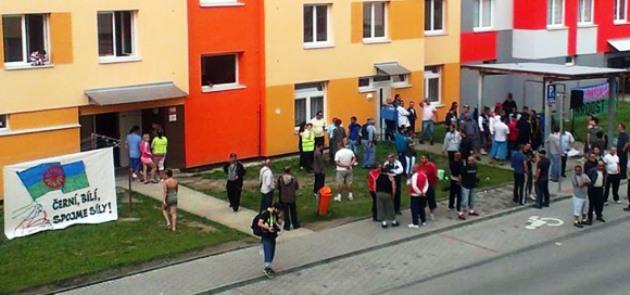Exactly one year ago, the town of České Budějovice became proof that social unrest wasn’t only happening in troubled areas in the north of the Czech Republic. Czech Radio reports that a study released by the Czech Government Agency for Social Inclusion now shows how this town, one of the wealthiest in the country, became the scene of violent street clashes last year.
The initial reasons for last year’s conflict actually began at the end of the 1980s, when the project for the construction of the Máj housing estate was changed. The apartment buildings there were raised by eight floors, making it possible to accommodate 500 people per hectare.
Completion of the construction meant that the space on Václav Volf Street became the most densely populated on the estate. Another unfortunate step was undertaken at the end of the 1990s, when the town hall designated a building on that street for social housing and moved impoverished Romani families there who had were being evicted from the city center.
According to former Czech Human Rights Commissioner Monika Šimůnková, Václav Volf Street was the worst possible place in which to have non-Romani and Romani neighbors living side by side. It almost seems to have been done intentionally.
That particular street and other parts of the housing estate gradually earned the bad reputation of being a Romani ghetto, and anyone who could afford to began to move away from it. Impoverished families had to remain there, and whenever any of them got into even greater difficulties, they sold their apartments or their shares in the cooperative ownership of them to new owners, all to pay off debts in the tens of thousands of crowns.
These impoverished residents then leased what had been their own property back from the new landlords, paying CZK 10 000 and more for them a month, or double what the normal market rent on that street was worth. That money, of course, was provided for these impoverished tenants by the Labor Office.
These social difficulties were intensified by the economic crisis of 2009, when the number of unemployed people living at Máj rose 50 %. Several Romani graduates of primary schools automatically enrolled at the Labor Office for assistance then.
One reason these Romani people were not able to compete on the labor market could be that they were segregated into the two local schools. During the first half of 2013, the number of crimes and misdemeanors committed at Máj also increased by 50 %.
Local residents complained that both the municipal and state police were simply ignoring many crimes. Part of the underworld began to focus on the production and distribution of drugs there, and drug users living at Máj are infamous for their lack of inhibitions, reportedly beginning their drug careers by shooting methamphetamine directly into their veins.
The racial conflict there last year began after an altercation on a playground which local press reported as an attack by Romani people on a pregnant "white" woman. Three racist marches then followed in which impoverished people from the majority (non-Romani) population of Máj actively participated on the side of the neo-Nazis, people who either live only on welfare, or who make so little money they can’t get along without some form of social support.
Today there is no trace of ethnic conflict at the Máj housing estate. At the intersection of Antonína Barcal and Milada Horáková Streets, where police officers were halting neo-Nazi marches last year, there is now a glass building housing the local community center, which is to be run by the Salesian Youth Center, which will run clubs and hobby groups for youth between the ages of three and 26.
